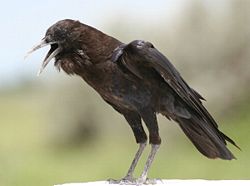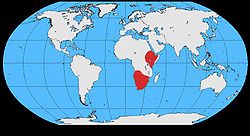- Cape Crow
-
Cape Crow or Black Crow 
Conservation status Scientific classification Kingdom: Animalia Phylum: Chordata Class: Aves Order: Passeriformes Family: Corvidae Genus: Corvus Species: C. capensis Binomial name Corvus capensis
Lichtenstein, 1823
The Cape Crow or Black Crow (Corvus capensis) is slightly larger (48–50 cm in length) than the Carrion Crow and is completely black with a slight gloss of purple in the feathers. It has proportionately longer legs, wings and tail too and has a much longer, slimmer bill that seems to be designed for probing into the ground for invertebrates. The head feathers have a coppery-purple gloss and the throat feathers are quite long and fluffed out in some calls and displays.
Contents
Distribution and habitat
This species occurs in two large separate regions of the African continent. One form ranges from the Cape at the southern tip of Africa up to southern Angola and across to the east coast of Mozambique. The other population occurs in a large area from Sudan, Ethiopia,Tanzania and Kenya in central east Africa. The more northern population is on average slightly smaller than the southern. It inhabits open grassland, moorland, agricultural areas with some trees or woodland in the vicinity for nesting. It seems to thrive especially in agricultural areas.
Behaviour
Diet
As far as feeding is concerned, it eats grain and other seeds, invertebrates which it digs for with powerful downward stabs of its long bill. It opens Maize before they are fully ripe, bulbs and fleshy roots of certain plants, frogs and small reptiles, fruits and berries. It takes the eggs and chicks of ground nesting birds and has been known to kill birds of up to a pound in weight (especially domestic poultry). It turns over the droppings of mammals for insects.
Nesting
Nesting is always in trees, usually near the top. It has been known to nest in shrubs but much less frequently. There are usually 3-4 eggs incubated over 18–19 days and fledged by around 38 days. Usually only 3 nestling's ever surviving.
Voice
The voice is describes as a "krrah.....krrah.....krrah" or a quicker "kah-kah-kah". It also make very loud, liquid bubbling sounds that carry quite a distance and also gives throaty chuckles. There is evidence that vocal mimicry is practiced too.
References
- BirdLife International (2004). Corvus capensis. 2006. IUCN Red List of Threatened Species. IUCN 2006. www.iucnredlist.org. Retrieved on 09 May 2006. Database entry includes justification for why this species is of least concern
External links
Photo Image Links
Video Links
- Cape Crow videos on the Internet Bird Collection
Extant species of family Corvidae Kingdom: Animalia · Phylum: Chordata · Class: Aves · Subclass: Neornithes · Superorder: Neognathae · Order: PasseriformesFamily Corvidae Choughs Treepies PlatysmurusTemnurusOriental
magpiesOld World jays PtilostomusStresemann's
BushcrowZavattariornis
Categories:- IUCN Red List least concern species
- Corvus
- Birds of Africa
- Birds of Kenya
Wikimedia Foundation. 2010.
Look at other dictionaries:
Cape crow — kapinė varna statusas T sritis zoologija | vardynas atitikmenys: lot. Corvus capensis angl. Cape crow vok. Kapkrähe, f rus. капский ворон, m pranc. corneille du Cap, f ryšiai: platesnis terminas – varnos … Paukščių pavadinimų žodynas
Crow Black Sky — Origin Cape Town, Western Cape, South Africa Genres Melodic Black Metal Years active 2009 Present Labels Independent … Wikipedia
Cape Cod Radio Mystery Theater — (CCRMT) is a group of voice actors and engineers committed to reviving the art of radio drama. The company was founded by Steven Thomas Oney, who produced the popular series of mysteries featuring Captain Waverly Underhill (voiced by David… … Wikipedia
Cape Dezhnev — Headlands and islands of the Bering Strait as seen from a point 25 miles south of the Diomede Islands. Cape Dezhnev on the far left. Cape Dezhnyov or Cape Dezhnev (Russian: мыс Дежнёва; formerly East Cape or Cape Vostochny) is a cape that forms… … Wikipedia
Pied Crow — In Etosha National Park, Namibia Conservation status … Wikipedia
List of birds of Cape Verde — This is a list of the bird species recorded in Cape Verde. The avifauna of Cape Verde includes a total of 187 species, of which 4 are endemic, 3 have been introduced by humans, and 75 are rare or accidental. 1 species listed is extirpated in Cape … Wikipedia
Sheryl Crow — For the English singer, see Cheryl Cole. Sheryl Crow Background information Birth name Sheryl Suzanne Crow Born … Wikipedia
Mount Jim Crow National Park — IUCN Category II (National Park) Coordinates 23°12′53″S 150°37′43″E … Wikipedia
2007 Cape Cod Baseball League Season — The 2007 Cape Cod Baseball League Season was the 45th in the Cape Cod Baseball League s Modern Era. It began on June 15th and continued through August 14th, when the Yarmouth Dennis Red Sox defeated the Falmouth Commodores to win the Cape Cod… … Wikipedia
Battle of Cape Passero (1940) — Infobox Military Conflict conflict=Battle of Cape Passero (1940) partof=the Mediterranean Theater of World War II caption=British light cruiser HMS Ajax . date=October 12 1940 place=Mediterranean, southeast of Sicily result=British victory… … Wikipedia

